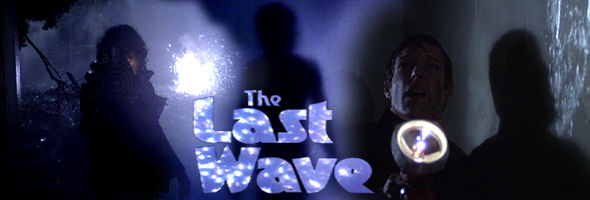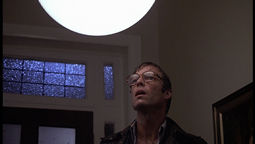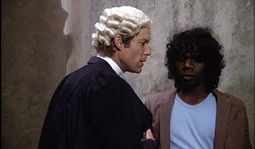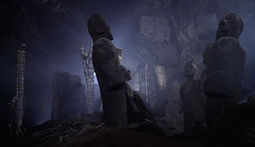
Color, 1977, 106 mins. / Directed by Peter Weir / Starring Richard Chamberlain, Olivia Hammett, David Gulpilil, Frederick Parslow, Vivean Gray / Music by Charles Wain / Cinematography by Russell Boyd
Format: DVD - Criterion (MSRP $29.95) / Letterboxed (1.78:1) (16:9 enhanced) / Dolby Digital 5.1
You'll never hear a rain shower in quite the same way after experiencing Peter Weir's The Last Wave, his third
After a quiet opening sequence in which an Aborigine paints colorful symbols inside a cave, the film presents the first of its many inexplicable incidents when a violent hailstorm pulverizes an outback schoolhouse in the middle of the afternoon... with nary a cloud in the sky. Meanwhile in Sydney, which has been pelted with an abnormal amount of strange rainfall, happily married tax lawyer David Burton (Richard Chamberlain) agrees to take on a side pro bono case defending a group of Aborigines implicated in the mysterious death of one of their own outside a bar. The accused turn out to be less than forthcoming, and soon David's dreams are invaded by visions of one of the Aborigines holding up a sacred stone. Even worse, David begins to suspect that his clients may be tuned in to a different plane of
Deliberately paced and filled with an almost suffocating atmosphere, The Last Wave requires some adjustment for viewers expecting a literal, cut and dry story which connects all of its dots. The exact roles of Aborigines (who thrive in tribes despite the imposition of major cities) and the more "civilized" European descendants appear to be constantly in flux, with each new revelation opening a new set of possibilities for our hapless protagonist. The introduction of uncanny elements (hordes of frogs, darkened rain, eerie rumblings) works because the film establishes an off kilter atmosphere from the beginning, and so the viewer can gradually accept the existence of supernatural (or technically preternatural) elements beneath the fabric of everyday
Like Picnic, The Last Wave had an elusive history on home video from the beginning. Warner issued the first, extremely scarce tape back in the mid-'80s, and it suffered from a muddy, hazy appearance which often left the film drenched in total blackness. After years on moratorium, Rhino eventually revived it on tape with a slightly improved transfer, though the film had still seen far better days. A promised laserdisc at the same time never materialized and the tape quickly disappeared, but Criterion's DVD has proven to be worth the wait. While the low budget '70s film stock is still evident in a few gritty looking night shots, the amount of detail visible here looks positively astounding compared to past tapes. The appearance is also faithful to the new restored prints Criterion struck for revival house screenings, and the transfer itself appears to be impeccable. Particularly interesting is the audio mix for the film, which is technically Dolby Digital 5.1 but not presented as newly retooled multi-channel mix. Instead the film remains largely monaural, with the LFE channel activated for some of the louder rain and thunder passages. Hearing the subwoofer suddenly kick in provides a solid shudder at strategic points, and the now famous final scene now packs a terrific, gut wrenching punch from an audio standpoint alone.
Extras on the disc are limited but were dictated by Weir's involvement in the project, which means we get the appropriately creepy theatrical trailer (featuring that great, Tangerine Dream style music) and an elliptical but interesting video interview with Weir, who discusses the film's production and its significance at a relatively early point in his career.
Color, 1975, 107 mins. / Directed by Peter Weir / Starring Rachel Roberts, Vivean Gray, Helen Morse, Anne-Louise Lambert, Dominic Guard, Martin Vaughan / Written by Cliff Green Format: DVD - Criterion (MSRP $29.95) / Letterboxed (1.66:1) / Dolby Digital 5.1
After a seeming eternity on video moratorium, Peter Weir's delirious Australian arthouse favorite has finally returned to video in a digitally restored transfer that will simply knock your socks off. The remixed Dolby Digital 5.1 soundtrack presents a film you have never experienced before, allowing the ethereal New Age score and natural sound effects to swirl around you and add immeasurably to the film's intoxicating atmosphere. Unprepared viewers may be puzzled at the fact that the film presents a mystery which in many ways it refuses to solve. Based on the 1967 Joan Linday novel, Weir's ode to female adolescene concerns a repressive girl's school led by Rachel Roberts. On Valentine's Day in 1900, the girls go out for an expedition to a wondrous natural volcanic formation called Hanging Rock. Three girls and a teacher vanish without a trace, sending the other students into a state of near hysteria. Criterion's edition also includes the original (very long) trailer and - at last! - optional subtitles for the hearing impaired. Here's the strange thing, though-- the packaging refers to this as "the long awaited director's cut of the film." Well, it looks like the same edited U.S. print to me, but apparently Weir oversaw the entire transfer and remixing process, so it's obviously this shorter edition that he prefers. However, the Japanese laserdisc edition (which looks much worse) runs nine minutes longer; this 116 minute version is the standard for the rest of the world. While Weir may not like the extended cut, it would have been nice to have some of the scissored bits included as an option for viewers who want to see what was cut. So basically, if you shelled out the bucks already for the Japanese LD, hold on to it! However, Criterion has obviously invested a great deal of care into this fragile miniature masterpiece, and this is easily the best way to see it.
 genre-bending "horror" film in a row after The Cars that Ate Paris and the sublime Picnic at Hanging Rock. His usual fascination with the collision between natural and constructed cultures remains prominent here, but the intrusion of the supernatural and uncanny becomes even more pronounced than Picnic. The result is an odd, mystical, and unsettling film which, given the current social climate, is now even more capable of inducing chills.
genre-bending "horror" film in a row after The Cars that Ate Paris and the sublime Picnic at Hanging Rock. His usual fascination with the collision between natural and constructed cultures remains prominent here, but the intrusion of the supernatural and uncanny becomes even more pronounced than Picnic. The result is an odd, mystical, and unsettling film which, given the current social climate, is now even more capable of inducing chills.
 consciousness (including a mysterious law of dreams) which foretells of an apocalypse by water.
consciousness (including a mysterious law of dreams) which foretells of an apocalypse by water.
 reality. In a sense Weir has crafted one of the better examples of dark magic realism on film, a genre which normally works better on the page than a movie screen. Chamberlain is also very good and subdued, proving again his status as a solid leading man before he eventually became bogged down in soppy TV projects.
reality. In a sense Weir has crafted one of the better examples of dark magic realism on film, a genre which normally works better on the page than a movie screen. Chamberlain is also very good and subdued, proving again his status as a solid leading man before he eventually became bogged down in soppy TV projects.

